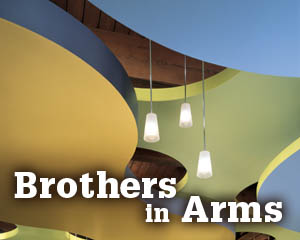
The Harold Washington Library Center, Wrigley Building, Sears Tower, Merchandise Mart and Holy Name Cathedral. These are just a few of the architecturally significant buildings in Chicago and around the country whose drywall and plaster work McNulty Bros. Co. has handled during the past century.
Domes, vaulted and tray ceilings, curved archways and soffits have become the norm as construction has moved away from flat walls and ceilings to more ornamental, dimensional looks. While these construction practices have been highly successful in commercial construction where budgets are big and architects are looking to wow, many of these practices are beginning to flow into residential construction. And with today's new tools, metal framing and drywall suspension systems taking the guesswork and exhausting hours out of the finished product, contractors can easily set themselves apart by being able to provide the dramatic add-ons a custom home builder may be seeking.
I started my career as a residential builder -on everything from the foundation to the roof. And in 1981, I joined McNulty Bros. So, with both residential and commercial construction backgrounds, it's easy to see where building practices can easily cross over from commercial buildings to family homes. The key is embracing metal framing instead of using wood to achieve the desired end results.
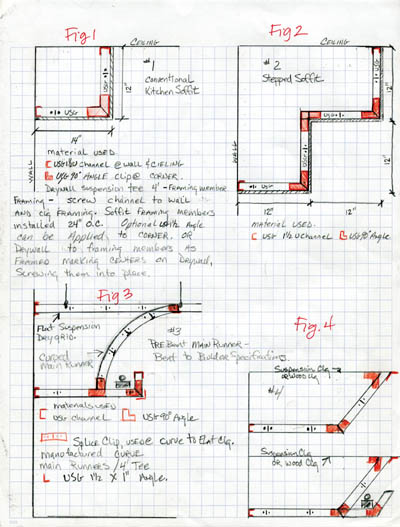
Advantages of working with metal
There are so many unique applications that are simply overlooked in residential construction due to the difficulty of working with wood framing. As a carpenter, I know that working with wood can be challenging. Even for constructing simple soffits, one has to worry about variances in size, warping, susceptibility to rotting or mold, and the fact that lumber just isn't always level. And for more complicated applications, cutting templates for domes or arches is incredibly time-intensive.While working with lumber on the job site has been standard protocol for the housing industry, metal framing is truly easier to work with. When properly sized and engineered, metal framing is not affected by shrinkage, warpage or twisting. For contractors, this means not having to spend hours sorting and sifting through stacks of lumber that have been dropped at the job site for the straight lumber. And although metal framing does continue to present interface problems with windows, doors, trim and other decorative moldings, it offers many installation benefits to contractors.
Another way metal wins out over wood is by eliminating the potential for mold-one of the industry's hottest issues. Metal is less susceptible to moisture. And on an open job site, this is crucial. If lumber is left out in the elements, moisture soaks into the wood. Too much moisture in wood can cause mold or nail or screw problems when the framing eventually dries out and shrinks. This shrinkage can cause nail pops or hairline cracks that will require expensive callback repairs.
Metal is also easier to cut on site. Installers don't need to bring a bevy of tools such as a circular saw, Sawzall or a drill for a hole saw for conduit or piping cutouts. Instead, battery-operated tools, hand aviation snips and small metal cutting bladed tools work well with metal. All the tools needed can be carried on a belt.
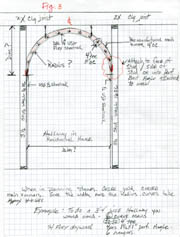
As easy as playing with an Erector Set
The construction industry is already recognizing the move to metal, and has introduced a variety of tools and accessories to simplify production. There are preformed radius metal domes and barrel ceilings, and preformed radius metal arches that can simplify production at the home site. These kits arrive on location manufactured to the project's specific requirements-just like giant Erector Sets from our childhood. By comparison, similar products made from wood are slow to fabricate and tough to replicate.I usually work with the USG Drywall Suspension System, which allows the creation of curved, domed and conventional flat drywall ceilings. Custom curved main tees combine with straight tees allow one to design a variety of ceilings from drywall barrel vaults, archways, valleys and domes, which can easily transition to flat ceilings, soffits and acoustical ceiling suspension systems.
The benefit of a system like this is that all main tees (straight and curved) can be field cut to specific lengths and are compatible with most acoustical suspension systems. A system like this can reduce installed costs vs. conventional cold-rolled channel or steel stud drywall ceiling installations.
Products, such as the drywall suspension system, really open up the opportunities for adding design to ceilings and enclosures including: kitchen soffits, design elements over kitchen islands, barrel ceilings, tray or coffer ceilings, bathrooms, basements and light pockets. Plus, it's also a great way to level old ceilings or add a new ceiling under old plaster during remodeling. It also provides an economical solution for hiding mechanical, plumbing and electrical systems during renovations.
Let's take a close look at specific examples of how the drywall suspension system can work on your next project to save you time and money while increasing the quality of your workmanship.
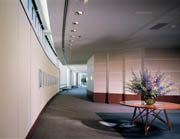
Soffits
Soffits are virtually synonymous with kitchens. They are typically used to fill in the open spaces between the ceiling and the tops of wall cabinets, but can also be used to add dramatic flair or to define specific workspaces. We've been doing a lot of cloud soffits over islands with lighting inside to define the workspace. On the practical side, soffits can hide electrical work or raw plumbing pipes.Using a suspension system is an easy way to achieve a conventional boxed soffit (Figure 1) above cabinets. In fact, soffit suspension system components are identical to the components used in flat surface areas. Simply use U-channels at the wall and ceiling and a 90-degree angle clip at the corner of the soffit. The pieces pop right into place-a true time savings for you and the custom builder for whom you may be working.
For a variation on the basic box soffit, a combination of 90-degree transition clips can be used to achieve a stepped soffit (Figure 2). Or use curved main tees in conjunction with a splice clip for a curved look.
Keep in mind that while they're traditional in the kitchen, soffits aren't limited to this area of the home. I've seen a trend toward more ornate ceiling treatments in the master bedroom with tray or coffer ceilings and even domes or vaulted ceilings. With a little variation on the standard, boxed kitchen soffit, one can achieve a custom builder's wish list with ease.
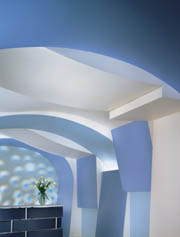
Vaults and arches
There was a time when building an archway meant scoring a piece of 1/2-inch drywall 100 times and screwing it onto a massive 2x4 frame. But today's systems have taken the guesswork out of the construction. Now, it's as simple as providing width and radius curve measurements to the manufacturer. The sections for an arched hallway or vaulted ceiling come back pre-engineered and ready to hang.Be sure to order curved main runners when in the planning stages, as it typically takes four to six weeks for the manufacturer to turn them around for specific needs.
While that timeframe may seem lengthy, the time saving in the long run is huge. And compared to other appliances and products-for example, three months for custom-made wood cabinets-six weeks is hardly a wait at all. Plus, the installation takes a matter of days vs. weeks. Because the manufacturer has eliminated all the guesswork of field bending and benching the shapes, you are assured a precisely curved finished product.
Some examples include an arched hallway (Figure 3), vaulted ceiling in an entryway or living room or a barrel ceiling over a sunken tub in a master bath. Paired with unique lighting, these designs can really add a unique look to a home.
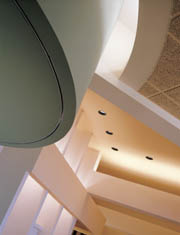
Remodeling
The benefits of using metal framing over wood not only can add pizzazz to new construction but can help from a structural standpoint when it comes to renovation work. A perfect example is finishing off a basement. If working on an older house or tackling a finished basement in a new home, there is probably a low ceiling and you're brainstorming on how to hide ugly ductwork, electrical wiring and plumbing.The drywall suspension system can easily be wrapped around the offending pipes and ducts to create a smooth ceiling surface while also maintaining maximum heights with minimum clearance. If it already has an 8-foot tall ceiling, don't go much lower. The suspension system measures in at 11⁄2 inches vs. 21⁄2 inches or more that you would have with a similar ceiling framed out of wood.
Another important feature of this type of drywall ceiling is that it easily transitions into an acoustical tile ceiling. While we were just trying to cover up ugly wires and pipes, the homeowner is still going to need to have access to the important inner workings of the home. This can be achieved by installing an acoustical ceiling system in just a portion of the basement. That way, you're not tied to having ceiling panels everywhere, which has long been standard in the old basement rec rooms of olden times.
Let's take a look at another time, labor and money saver for the remodeler-replacing a plaster ceiling. Instead of demolishing the old plaster ceiling, a new lightweight and strong drywall ceiling can be constructed.
The advantages are many. First, you don't have to demolish the old plaster ceiling, saving labor costs and eliminating the trash that would go along with such a project. It also enables you to run all mechanical, plumbing, electrical, phone and cable through the ceiling. With this new flexible ceiling, you create more options for items such as light pocket soffits, island clouds or other curved design elements.
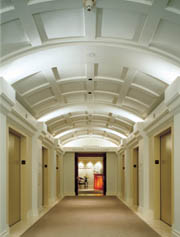
Fixing imperfections
One of the challenges contractors face when renovating or adding an addition on a home is the state of the old wood framing. Wood members can vary pretty drastically in width and height-from 91⁄8 to 91⁄2 inches. If you try to build a soffit on a ceiling that's not level, you'll just end up with a soffit that is crowned up or down, mirroring the imperfections in the joists. By using a U-channel from the suspension system, you can pick up these variances in lumber without having to add trim or filler. The result is a level, flat soffit. And for the carpenter, this means a huge time savings and a perfect end product.As you can see, today's innovative new ceiling products can truly help to set you apart as a walls and ceilings contractor. While the old-fashioned way of achieving dramatic looks was time-consuming and expensive, today you can achieve high quality, dramatic soffits and arches in half the time. As everyone realizes, time equals money. With labor costs rising, any way to cut a job's hours adds to your bottom line while also lowering prices for your customers. The end result leaves you more competitive in the marketplace, and custom builders will turn to you and your expertise to make a dramatic statement without breaking their budgets. It's a beneficial situation for everyone.

Report Abusive Comment